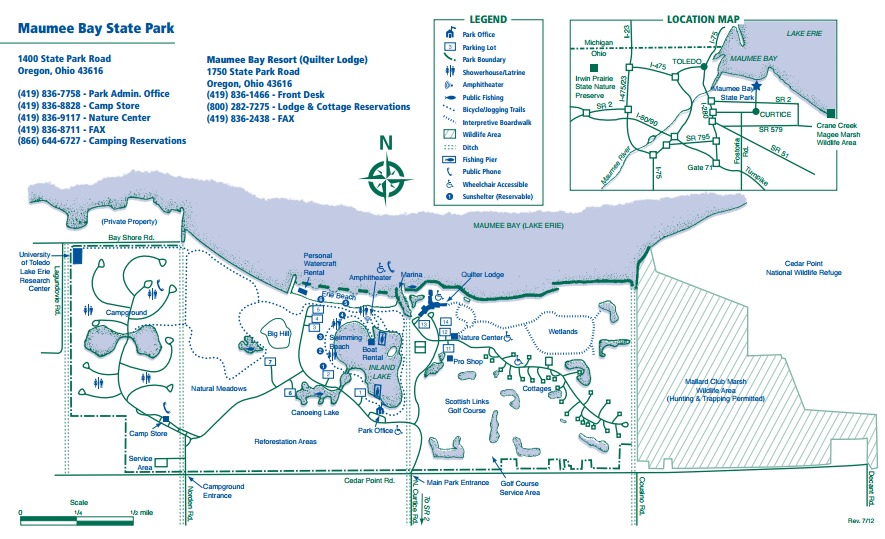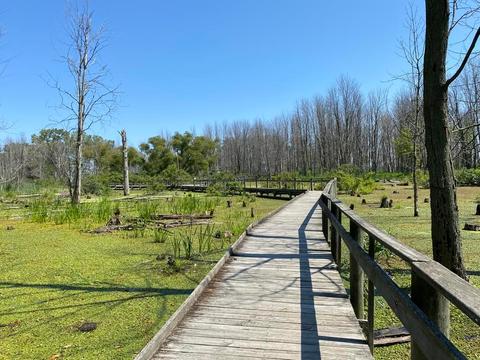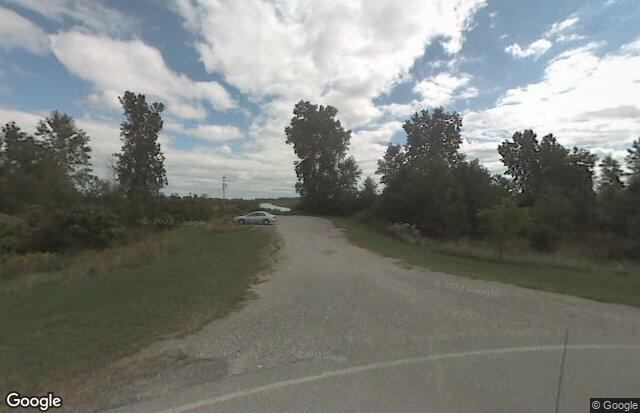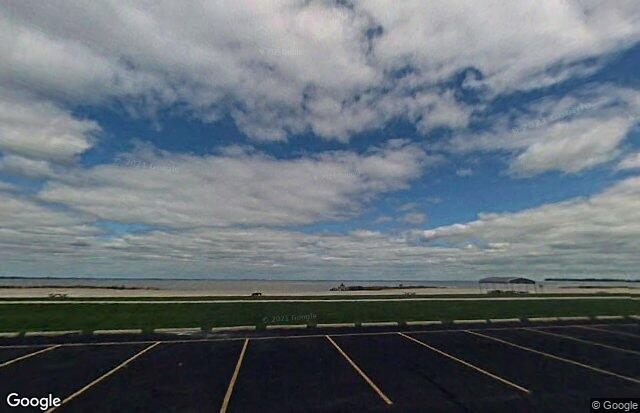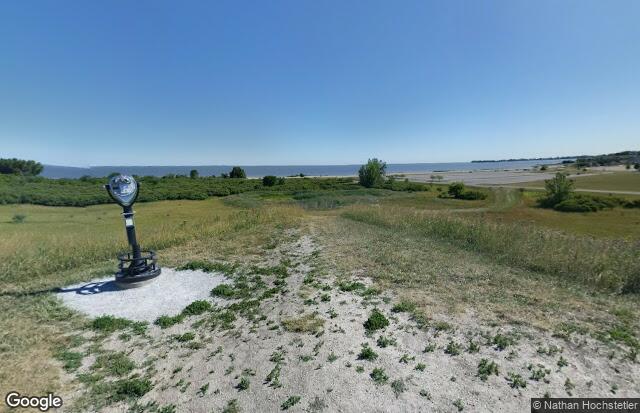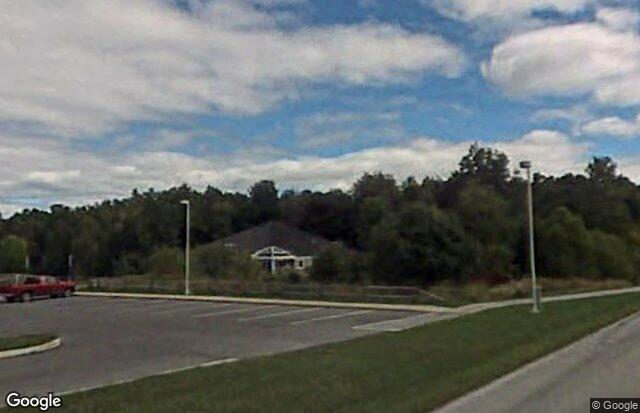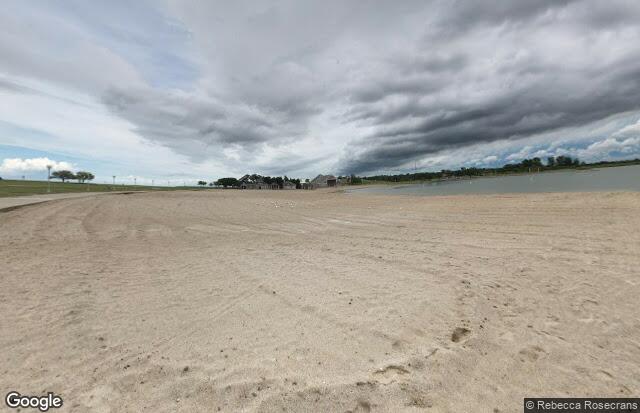
Maumee Bay State Park
Maumee Bay State Park
1400 State Park Road Oregon, Ohio 43616
Official WebsiteMaumee Bay State Park Lodge website
Maumee Bay State Park map
Tips for Birding
When submitting eBird observations at Maumee Bay State Park, it is most helpful to start a new checklist for each hotspot in the park. Use the general hotspot when you have a checklist that includes multiple locations or if no other hotspot or personal location is appropriate for your sightings.
Maumee Bay State Park is situated on the south shore of Maumee Bay in extreme western Lake Erie. It is approximately 1500 acres in extent. Bird habitats are many: Open water of Maumee Bay, sand beach, inland ponds, swamp forest, wet meadow, upland meadow, and cottonwood/hawthorn/dogwood thickets. Access to all of the habitats is easy via the excellent system of blacktop roads in the park.
On the eastern side of the park, leading from the Trautman Nature Center is a wonderful boardwalk that winds for about a mile through swamp forest and stands of Phragmites. A blacktop bike trail encircles much of the park, connecting the lodge area with the campground on the west side of the park. Other grassy trails crisscross the central section of the park. There is a sledding hill just west of the beach parking lot that birders use as a lookout for hawk-watching in the spring.
From Wheeling Street on the east side of Oregon, proceed east on OH-2 approximately 6 miles to North Curtice Road. Turn north for 2.5 miles to the park entrance. Directions from OH-2 to the park are marked. There is a second entrance to the park one mile west along Cedar Point Road.
Parking areas are found throughout the park, including at the lodge, the nature center, the sledding hill, the beach area, picnic areas, and the campground.
The park also hosts an excellent lodge and conference area, modern cottages, a large campground, and a challenging golf course. It is a popular site for windsurfing.
Maumee Bay State Park is a stop on the Lake Erie Birding Trail.
Birds of Interest
Winter
Raptors winter in fair numbers in the park. Of particular interest are Short-eared and Long-eared Owls, both of which occur regularly. Short-eared Owls are especially visible at dusk just north and west of the sledding hill in the more open meadows. Winter also brings Rough-legged Hawks to the park and occasionally rarer species like Snowy Owl and Northern Goshawk. The numbers of owls vary with the abundance of Meadow voles in the park. Depending on the extent of ice on Lake Erie, diving ducks and gulls can be abundant. Among the ducks, expect large numbers of scaups, Common Mergansers, and Common Goldeneyes. Gull watchers hope for Glaucous, Iceland, and lesser black-backed among the many Herring and Ring-billed Gulls. Songbirds are relatively scarce at this time of year, but observers can often find Snow Buntings and perhaps a Northern Shrike.
Spring
Spring arrives early here, with the arrival of more ducks in late January and February. Large flocks of blackbirds (some have overwintered) are common in February and March and the hawks are on the move on days when winds are out of the southwest. Good numbers of Red-tailed and Red-shouldered Hawks are often seen in March; occasional Golden Eagles are noted; accipiters, especially Sharp-shinned Hawks, become more common in April as do Ospreys; and in late April, large numbers of Broad-winged Hawks can be encountered. Numbers of Lapland Longspurs can often be seen migrating along the lakeshore from late February into April. The inland beach as well as the lakeside beach usually host a few shorebirds each spring, notably Sanderlings, Red Knots, and Ruddy Turnstones. Get there before the hoards of park visitors disturb the birds. Songbird migration in late April and May can be excellent with over 30 species of warblers present plus many other Neotropical migrants. Check the boardwalk area and the shrubby thickets for these migrants.
Summer
Bird activity is not as great during the summer months, but the fall migration of shorebirds begins in earnest in early July and early risers may find a few species on the beaches and grassy areas near the beach parking lot. Buff-breasted Sandpipers are occasionally seen here and Upland Sandpipers used to nest before the cottonwoods took over so much of the park. Eastern Meadowlarks and Savannah Sparrows use the fields for breeding and Yellow Warblers, Warbling Vireos, and Yellow-billed Cuckoos use the thickets and cottonwoods. American Woodcocks are common and Eastern Screech-owls are easy to hear in the swamp forest east of the nature center.
Fall
The fall season starts with the aforementioned shorebird migration in July. In mid-August, the first of the fall warblers are detected and peaks are reached just after Labor Day. A few warbler species will linger through October. Blue-winged and Green-winged Teals make up the vanguard of the duck migration in September and numbers of all species will build into November when the greatest diversity is reached. At this time of year. scoters and Long-tailed Ducks should be looked for on the bay and the rare Greater White-fronted Goose in flocks of abundant Canada geese. The large numbers of Bonaparte’s Gulls on the bay should also be scrutinized for their rarer cousins.
About this Location
Maumee Bay State Park is a tribute to Lake Erie. This precious gift is one of the largest bodies of fresh water in the world and it reflects the diverse natural heritage of Ohio.
The history of Lake Erie began with the glacial period known as the Pleistocene. Massive sheets of ice gouged and scoured the bedrock of Ohio. Testimony of the ice’s force is found throughout the lake area. Small scratches in the rock surface known as glacial striations are common, while major grooves are rare but awesome.
The wetlands of the Maumee Bay area offer a vivid array of natural wonders. Wetlands contain more species of wildlife than any other habitat type, including fox snakes, northern water snakes, painted turtles, chorus frogs, green frogs, spotted salamanders, raccoons, muskrats, dragonflies, caddis flies, and water striders. Over 300 species of birds have been recorded with shorebirds such as snipe, great blue heron, common gallinule, and ring-billed gulls residing with waterfowl including Canada geese, pintails, redheads, and ruddy ducks. Songbirds include the red-winged blackbird, yellow warbler, killdeer, and swamp sparrow. Spring migration brings many others including the colorful warblers. The plant life is diverse as well. Cattails, buttonbush, phragmites, bur-reed, cottonwood, and black willow are just a few examples of marsh plants at the park.
In addition to marsh and swamp wetlands, several prairies add more diversity to the landscape. Ring-necked pheasants densely populate the meadow areas of the park.
The Lake Erie shoreline sets the stage for the comeback of the bald eagle in Ohio. Nesting pairs have been reported recently in Ohio with the majority being in the western basin of Lake Erie.
Notable Trails
Maumee Bay State Park Trails
Maumee Bay State Park is home to several miles of trails that will take you through swamp and marsh wetlands, open meadows, ponds, and beaches. The nature center’s interpretive boardwalk trail is wheelchair accessible. Enjoy great views of Lake Erie while you hike or bike. A multipurpose trail is open to hiking and cross-country skiing.
Inland Lake (paved biking and jogging) – 3 miles
Interpretive Boardwalk (hiking) ADA accessible – 2 miles
Multi-Use Trail – 2.5 miles
Mouse Trail (hiking) – 2.5 miles – Easy
Descriptions with photos and maps of hikes on the Boardwalk at Maumee Bay State Park are available on the AllTrails website.
Features
Restrooms on site
Content from Ohio Ornithological Society and Maumee Bay webpage
Last updated February 7, 2024
